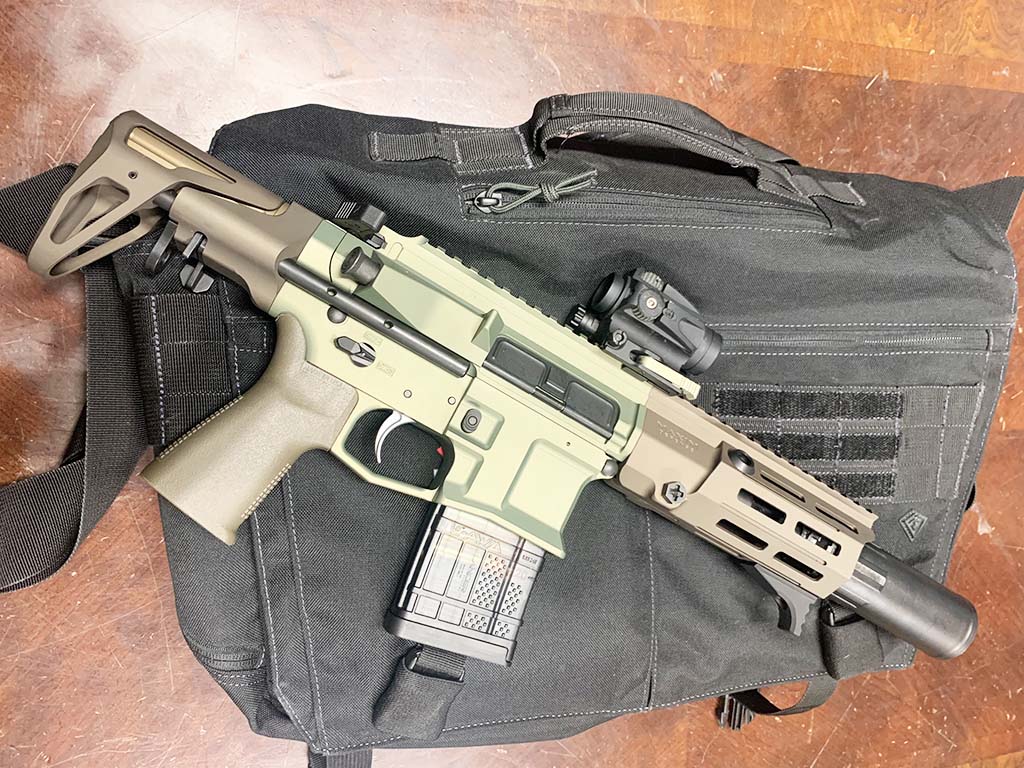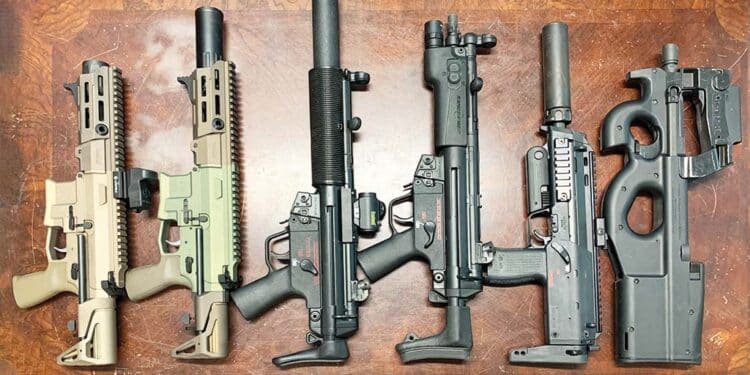By Dennis Bechtel

What makes a “Personal Defense Weapon” (PDW)? This is a widely-discussed term that can mean different things to different people. Do we assign this term to weapon systems based on the caliber they use, overall length of weapon, total weight or intended use?
When I hear the term PDW, I immediately start thinking about the FN P90 or HK MP5 systems and, in recent years, the HK MP7. There are several others that come to mind, but over the years these specific weapons have shown up again and again in movies, video games and on the pages of the magazines you browse through at the local store. They were purpose-built for specific jobs and are smaller, compact weapon systems that are lightweight and easy-to-use with low recoil. This makes them easier to use than assault rifles and carbines, especially for those in tight spaces such as pilots, engineers and heavy machine gun crew members. For example, pilots were in need of something they could use in case of bailout or crash. This need stemmed from the fact that the bailout bags at the time only allowed them to place their full-size weapons into the bags in two parts, rather than together and ready-to-use. Situations like this made it easy to justify the need for PDW use in the military, Special Operations and law enforcement.
As we look into the evolution of the PDW, we see that when the concept started it was intended to be a smaller, lightweight, compact system that used smaller calibers like 9mm, .40 cal, .45 ACP, and the newer 5.7x28mm and 4.6x30mm. At first, these criteria worked and met what was asked for at the time. As time moved on, new and specific requirements developed and the PDW needed to evolve, and so it did.
Manufacturers started making weapons smaller with shorter barrels, or bullpup designs, and this allowed the PDW to move into rifle calibers like 5.56mm, 7.62x39mm, 6.8mm Remington SPC and .300 Blackout, as well as some other calibers that were made specifically for the rifle that was being designed. FN, Knight’s Armament Company, HK, Colt, Daniel Defense and B&T AG are just a few manufacturers that designed PDWs around both newer cartridges and common cartridges.
These new PDWs with rifle calibers would allow for the PDW to go toe-to-toe with larger, full-size weapons systems but in a new, compact system size. With this change in design came new companies that started making the PDW shorter from both ends, rather than just with shorter barrels or collapsible/side-folding stocks. These newest changes have allowed the PDW to still be used by the military, law enforcement, protection details or even the normal American citizen, allowing them to have heavy firepower while still being able to maintain that needed “element of surprise,” as well as discretion.

Maxim Defense Industries PDX in .300 Blackout with CGS “Maxim” suppressor and Aimpoint CompM5b optic.
These advancements have given end users the ability to have a small weapon system with maximum firepower. Some of the advancements came from shorter barrels or the use of side-folding stocks, but I mentioned before that companies started making the PDW shorter from both ends. An example of this is Maxim Defense Industries. They designed from both ends of the PDW and made it work. Maxim Defense, which started as a stock and brace company, cut their teeth in the PDW arena when they created their PDX in response to a SOCOM PDW solicitation. The PDX combines a 5.5-inch barrel with a rapid deploying stock system that allows the user to shoot in both the open and closed positions. When you combine these features with the fact that it measures only 18.75 inches overall (21.5 inches with Maxim’s suppressor) and weighs in at 5 lbs., 11 oz., you have a compact system that allows you to deliver max firepower. As opposed to a “Personal Defense Weapon,” making these smaller systems work as effective, reliable weapons would be better termed “Purpose-Designed Weapon.”
To put this in perspective, the HK MP5SD has an overall length of 25.98 inches and weighs in at 7 lbs., 8 oz. For those of you who prefer a more practical comparison, look at the Maxim PDX as this: it is just over three U.S. dollar bills long and weighs less than one gallon of milk. This size and weight allow the PDW to fit into most standard laptop cases, backpacks and, in some instances, tennis racket cases. Since this type of PDW can be placed inside a bag, it can be more easily used by School Resource Officers and other personnel who need to have a discreet system in a small package with maximum firepower. This also allows you to be able to travel and take your PDW with you and have it ready for use, not broken apart in two separate pieces, and you don’t have to worry about whether or not someone will see what you brought to the party.
This reduction in size makes the PDW easy to use in vehicles; its compact design allows easy maneuverability, especially when going in and out of the vehicle or in a security detail.
The “Purpose-Designed Weapon” has gone through many changes over the years, leading us to where we are today: with small, light, compact weapons capable of firing rifle calibers along with pistol calibers. This modern PDW is like the adult version of Legos. You have the ability to configure your PDW the way you want, in the caliber you want, from .22 to .458 SOCOM. You can make your PDW small (from the back with side-folding or collapsible stocks or from the front with shorter barrels). Since they are like Legos, the user can have different setups for different mission sets or uses; they have options without having to bring multiple firearms.
Another change that has helped fuel the advancements with the PDW was the creation of ammunition specifically designed for short-barreled rifles. Similar advancements were done for compact handguns when it was noticed that users were not getting the full potential from them. This has allowed for the PDW to be purpose-built, designed so that you get a small, compact system that gives you max results and performance. Time will tell what the future holds for the PDW and what evolution the system will follow. I can’t wait to see what the future holds and what the next big change will be to the system. The imagination is the only thing that will limit what can be the next PDW.
This article first appeared in Small Arms Review V25N5 (May 2021)












